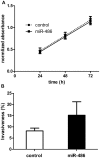MicroRNAs associated with metastatic prostate cancer - PubMed (original) (raw)
MicroRNAs associated with metastatic prostate cancer
Akira Watahiki et al. PLoS One. 2011.
Abstract
Objective: Metastasis is the most common cause of death of prostate cancer patients. Identification of specific metastasis biomarkers and novel therapeutic targets is considered essential for improved prognosis and management of the disease. MicroRNAs (miRNAs) form a class of non-coding small RNA molecules considered to be key regulators of gene expression. Their dysregulation has been shown to play a role in cancer onset, progression and metastasis, and miRNAs represent a promising new class of cancer biomarkers. The objective of this study was to identify down- and up-regulated miRNAs in prostate cancer that could provide potential biomarkers and/or therapeutic targets for prostate cancer metastasis.
Methods: Next generation sequencing technology was applied to identify differentially expressed miRNAs in a transplantable metastatic versus a non-metastatic prostate cancer xenograft line, both derived from one patient's primary cancer. The xenografts were developed via subrenal capsule grafting of cancer tissue into NOD/SCID mice, a methodology that tends to preserve properties of the original cancers (e.g., tumor heterogeneity, genetic profiles).
Results: Differentially expressed known miRNAs, isomiRs and 36 novel miRNAs were identified. A number of these miRNAs (21/104) have previously been reported to show similar down- or up-regulation in prostate cancers relative to normal prostate tissue, and some of them (e.g., miR-16, miR-34a, miR-126*, miR-145, miR-205) have been linked to prostate cancer metastasis, supporting the validity of the analytical approach.
Conclusions: The use of metastatic and non-metastatic prostate cancer subrenal capsule xenografts derived from one patient's cancer makes it likely that the differentially expressed miRNAs identified in this study include potential biomarkers and/or therapeutic targets for human prostate cancer metastasis.
Conflict of interest statement
Competing Interests: The authors declare that no competing interests exist.
Figures
Figure 1. Effects of overexpression of miR-486 on proliferation and tissue invasiveness of 22Rv1 human prostate cancer cells.
A) As indicated by MTT assay, there was no significant difference between the growth of miR-486-transfected cells and control cells over a 72-hr period. B) Tissue invasiveness, as measured by Matrigel invasion, of miR-486 transfected cells and control cells. Data are expressed as percent invasiveness ± S.D. and show increased invasiveness of miR-486-transfected cells (85% ; p = 0.08).
Similar articles
- The potential of microRNAs as human prostate cancer biomarkers: A meta-analysis of related studies.
Song CJ, Chen H, Chen LZ, Ru GM, Guo JJ, Ding QN. Song CJ, et al. J Cell Biochem. 2018 Mar;119(3):2763-2786. doi: 10.1002/jcb.26445. Epub 2017 Dec 4. J Cell Biochem. 2018. PMID: 29095529 Free PMC article. Review. - Biomarker microRNAs for prostate cancer metastasis: screened with a network vulnerability analysis model.
Lin Y, Chen F, Shen L, Tang X, Du C, Sun Z, Ding H, Chen J, Shen B. Lin Y, et al. J Transl Med. 2018 May 21;16(1):134. doi: 10.1186/s12967-018-1506-7. J Transl Med. 2018. PMID: 29784056 Free PMC article. - ASAP1, a gene at 8q24, is associated with prostate cancer metastasis.
Lin D, Watahiki A, Bayani J, Zhang F, Liu L, Ling V, Sadar MD, English J, Fazli L, So A, Gout PW, Gleave M, Squire JA, Wang YZ. Lin D, et al. Cancer Res. 2008 Jun 1;68(11):4352-9. doi: 10.1158/0008-5472.CAN-07-5237. Cancer Res. 2008. PMID: 18519696 - Role of microRNAs in endocrine cancer metastasis.
Lima CR, Gomes CC, Santos MF. Lima CR, et al. Mol Cell Endocrinol. 2017 Nov 15;456:62-75. doi: 10.1016/j.mce.2017.03.015. Epub 2017 Mar 18. Mol Cell Endocrinol. 2017. PMID: 28322989 Review.
Cited by
- Downregulation of miR-34a in breast tumors is not associated with either p53 mutations or promoter hypermethylation while it correlates with metastasis.
Javeri A, Ghaffarpour M, Taha MF, Houshmand M. Javeri A, et al. Med Oncol. 2013 Mar;30(1):413. doi: 10.1007/s12032-012-0413-7. Epub 2013 Jan 6. Med Oncol. 2013. PMID: 23292869 - MiR-221 promotes the development of androgen independence in prostate cancer cells via downregulation of HECTD2 and RAB1A.
Sun T, Wang X, He HH, Sweeney CJ, Liu SX, Brown M, Balk S, Lee GS, Kantoff PW. Sun T, et al. Oncogene. 2014 May 22;33(21):2790-800. doi: 10.1038/onc.2013.230. Epub 2013 Jun 17. Oncogene. 2014. PMID: 23770851 Free PMC article. - Urinary exosome microRNA signatures as a noninvasive prognostic biomarker for prostate cancer.
Shin S, Park YH, Jung SH, Jang SH, Kim MY, Lee JY, Chung YJ. Shin S, et al. NPJ Genom Med. 2021 Jun 11;6(1):45. doi: 10.1038/s41525-021-00212-w. NPJ Genom Med. 2021. PMID: 34117264 Free PMC article. - In vitro and in vivo model systems used in prostate cancer research.
Cunningham D, You Z. Cunningham D, et al. J Biol Methods. 2015;2(1):e17. doi: 10.14440/jbm.2015.63. J Biol Methods. 2015. PMID: 26146646 Free PMC article. - Detecting microRNAs of high influence on protein functional interaction networks: a prostate cancer case study.
Alshalalfa M, Bader GD, Goldenberg A, Morris Q, Alhajj R. Alshalalfa M, et al. BMC Syst Biol. 2012 Aug 28;6:112. doi: 10.1186/1752-0509-6-112. BMC Syst Biol. 2012. PMID: 22929553 Free PMC article.
References
- Jemal A, Siegel R, Xu J, Ward E. Cancer statistics, 2010. CA Cancer J Clin. 2010;60:277–300. - PubMed
- Makarov DV, Loeb S, Getzenberg RH, Partin AW. Biomarkers for prostate cancer. Annu Rev Med. 2009;60:139–151. - PubMed
- Valencia-Sanchez MA, Liu J, Hannon GJ, Parker R. Control of translation and mRNA degradation by miRNAs and siRNAs. Genes Dev. 2006;20:515–524. - PubMed
Publication types
MeSH terms
Substances
LinkOut - more resources
Full Text Sources
Other Literature Sources
Medical
Molecular Biology Databases
